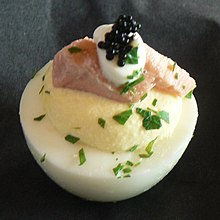Hors d'oeuvre: Difference between revisions
No edit summary |
No edit summary |
||
| Line 2: | Line 2: | ||
{{Meals}} |
{{Meals}} |
||
'''Hors d'œuvre''' ({{pron-en| |
'''Hors d'œuvre''' ({{pron-en|ɔrˈdɜvr}}; {{IPA-fr|ɔʁˈdœvʁ|lang|Fr-hors d oeuvre-fr-Paris.ogg}}, literally "apart from the main work"<ref>{{cite web|url=http://www.etymonline.com/index.php?term=hors+d%27oeuvre |title=Hors d'œuvre entry in the Online Etymology Dictionary |publisher=Etymonline.com |date= |accessdate=2010-01-31}}</ref>) or '''appetizers''' are [[food]] items served before the main courses of a [[meal]].<ref>{{cite web|url=http://www.answers.com/topic/hors-d-oeuvre |title=hors d'oeuvre: Definition from |publisher=Answers.com |date= |accessdate=2010-01-31}}</ref> The French (singular and plural) is ''hors d'œuvre''; in English, the ''œ'' ligature is usually replaced by the 2-letter sequence "oe" with the plural often written as "hors d'oeuvres" and {{pron-en|ɔrˈdɜrv}}. |
||
There are several related terms, such as a one-bite appetizer, as an [[amuse-bouche]] (or other terms below, under: ''[[#See also|See also]]''). |
There are several related terms, such as a one-bite appetizer, as an [[amuse-bouche]] (or other terms below, under: ''[[#See also|See also]]''). |
||
Revision as of 22:19, 26 June 2010
This article needs additional citations for verification. (October 2009) |
| Part of a series on |
| Meals |
|---|
 |
| Meals |
| Components and courses |
| Related concepts |
Hors d'œuvre (Template:Pron-en; French: [ɔʁˈdœvʁ] , literally "apart from the main work"[1]) or appetizers are food items served before the main courses of a meal.[2] The French (singular and plural) is hors d'œuvre; in English, the œ ligature is usually replaced by the 2-letter sequence "oe" with the plural often written as "hors d'oeuvres" and Template:Pron-en. There are several related terms, such as a one-bite appetizer, as an amuse-bouche (or other terms below, under: See also).
Use

If there is an extended period between when guests arrive and when the meal is served (for example during a cocktail hour), these might also serve the purpose of sustaining guests during the wait, in the same way that aperitifs are served as a drink before meals. Hors d'oeuvre are sometimes served with no meal afterward. This is the case with many reception and cocktail party events.
Hors d'oeuvre may be served at the table, as a part of the sit-down meal, or they may be served before sitting at the table. Hors d'oeuvre prior to a meal are either stationary or passed. Stationary hors d'oeuvre are also referred to as "table hors d'oeuvre". Passed hors d'oeuvre are also referred to as "butler-style" or "butlered" hors d'oeuvre.
Though any food served prior to the main course is technically an hors d'oeuvre, the phrase is generally limited to individual items, not crudités, cheese or fruit. For example, a glazed fig topped with mascarpone and wrapped with prosciutto is considered an "hors d'oeuvre," whereas figs on a platter are not.
A more substantial starter or first course served at the table might be referred to as an entrée (outside the U.S. and English Canada).
Hors d'oeuvre might include:
- Canapés
- Cold cuts
- Crudités (raw vegetables used for dipping)
- Deviled eggs
- Cheeses
- Sausages
- Dumplings
- Bruschetta
- Cocktail wieners
- Tongue toast
Other languages and cultures
- Zakuski are hors d'oeuvre served in Russian cuisines. Usually presented buffet style, it often consists of cured meats and fishes, various pickled vegetables such as carrots, cucumbers, and garlic, prepared salads, caviar, and breads. Zakuski are often offered with vodka.
- In China, it is called lěng pán 冷盘 ("cold plate"), qián cài 前菜 ("before dish"), or xiǎo cài 小菜 ("small dish") in Mandarin.
- Zensai (前菜, lit. before dish) is Japanese hors d'œuvre.
Media
-
Swiss cuisine (Schynige Platte)
-
Crudités variées
-
A selection of modern hors d'oeuvre
-
Various hors d'oeuvre at a Romanian banquet
-
Arab Meze
See also
- Amuse-bouche
- Antipasto
- Cicchetti
- Dim sum
- Finger food
- Garnish (food)
- Kujulpan
- Meze
- Picada
- Pu pu platter
- Sushi
- Tapas
- Zakuski
- Smörgåsbord
References
- ^ "Hors d'œuvre entry in the Online Etymology Dictionary". Etymonline.com. Retrieved 2010-01-31.
- ^ "hors d'oeuvre: Definition from". Answers.com. Retrieved 2010-01-31.





